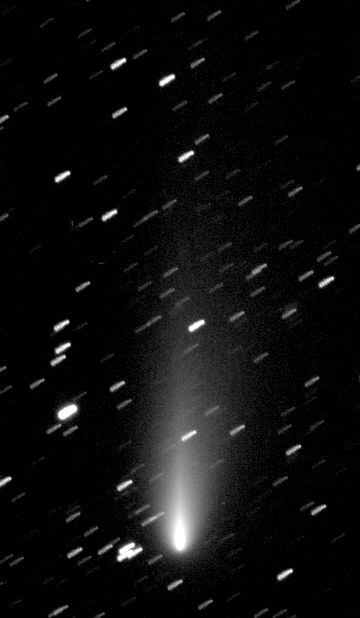
This image of comet C/1999 S4 (LINEAR) was taken on July 2 as the comet was swiftly moving from Andromeda into Perseus. The comet was moving so quickly, the background stars trailed considerably as the CCD tracked the comet. The length of the star trails in this exposure shows how far the comet moved in about 11 minutes.
This comet was discovered by the Lincoln Laboratory Near Earth Asteroid Research (LINEAR) project. The LINEAR automated minor-planet survey discovers quite a few comets as a by-product of the search for asteroids. This comet was nearly as far out in the solar system as the orbit of Jupiter when it was discovered in September 1999. It will pass 114 million kilometers from the sun, and came as close as 56 million kilometers to earth when it neared perihelion in July, 2000.
Comets are essentially dirty snow-balls, and are believed to contain material left over from the formation of the solar system. Comets spend most of their time far from the inner solar system in a region beyond the plant Pluto known as the Oort Cloud, orbiting at a distance of about half a light year from the Sun. When a comet is out in the Oort Cloud, it is much too far away to be seen from Earth. Comets are only discovered when the comet's orbit brings it into the inner solar system. When that happens, the heat from the Sun causes outer frozen layers of the comet to "melt" or sublimate, and the comet grows a tail. The orbit for this comet suggests that this is perhaps its first trip through the inner solar system.
This is a composite CCD image of six 60 second exposures taken with an ST-8E using a Takahashi FS-128 refractor telescope at f8. The image was taken at Windowpane Observatory's primary Northern Arizona observing location near Prescott. Special thanks to Bill Georgevich for his assistance and hospitality during my observing night.
Constellation: Andromeda
RA: 02h 37m Dec: +43d 36'
July 2, 2000 at 1040 U.T.
Image by Sid Leach
Prescott, Arizona
Recent Images.
Complete list of images.
Description of equipment used to acquire images.
Home
Feedback and comments should go to Sid